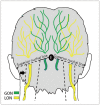Sensory complications in patients after scalp mass excision and its anatomical considerations
- PMID: 25024823
- PMCID: PMC4094744
- DOI: 10.3340/jkns.2014.55.4.200
Sensory complications in patients after scalp mass excision and its anatomical considerations
Abstract
Objective: To evaluate the incidence of postsurgical sensory complications in patients with scalp masses and classify the locations of them from a surgical standpoint according to anatomical considerations.
Methods: A total of 121 patients who underwent surgery for scalp mass were included in this study. The authors reviewed medical records and preoperative radiologic images. We investigated the complications related to sensory changes after procedure. Enrolled patients have been divided into three groups. Group A included patients with tumors above the superior nuchal line (SNL), Group B with tumors within the trapezius muscle area and patients who had tumors on the lateral trapezius muscle area were assigned to Group C. We compared the incidence related to postoperative sensory complications and summarized their additional treatments for these with clinical outcome.
Results: There were 12 patients (10%) with sensory complications related on the mass excision site (Group A: 1 patient, Group B: 2 patients, Group C: 9 patients). Six patients were affected with lesser occipital nerve (LON), 2 patients on greater occipital nerve (GON) and 4 patients on GON and LON. Over 6 months after surgery, two of the twelve patients with sensory complications did not have complete recovered pain in spite of proper medications and local chemical neurolysis with 1.0% lidocaine and dexamethasone.
Conclusion: Occipital neuropathy should be considered as a complication related excision of scalp mass. The sensory complications are more frequent in Group C because of the anatomical characteristics of the occipital nerves and there were no statistical difference for other variables.
Keywords: Greater occipital nerve; Lesser occipital nerve; Occipital nerves; Occipital neuralgia; Scalp mass; Third occipital nerve.
Figures


References
-
- Ahn NU, Ahn UM, Ipsen B, An HS. Mechanical neck pain and cervicogenic headache. Neurosurgery. 2007;60(1 Supp1 1):S21–S27. - PubMed
-
- Biousse V, D'Anglejan-Chatillon J, Massiou H, Bousser MG. Head pain in non-traumatic carotid artery dissection: a series of 65 patients. Cephalalgia. 1994;14:33–36. - PubMed
LinkOut - more resources
Full Text Sources
Other Literature Sources
Miscellaneous

